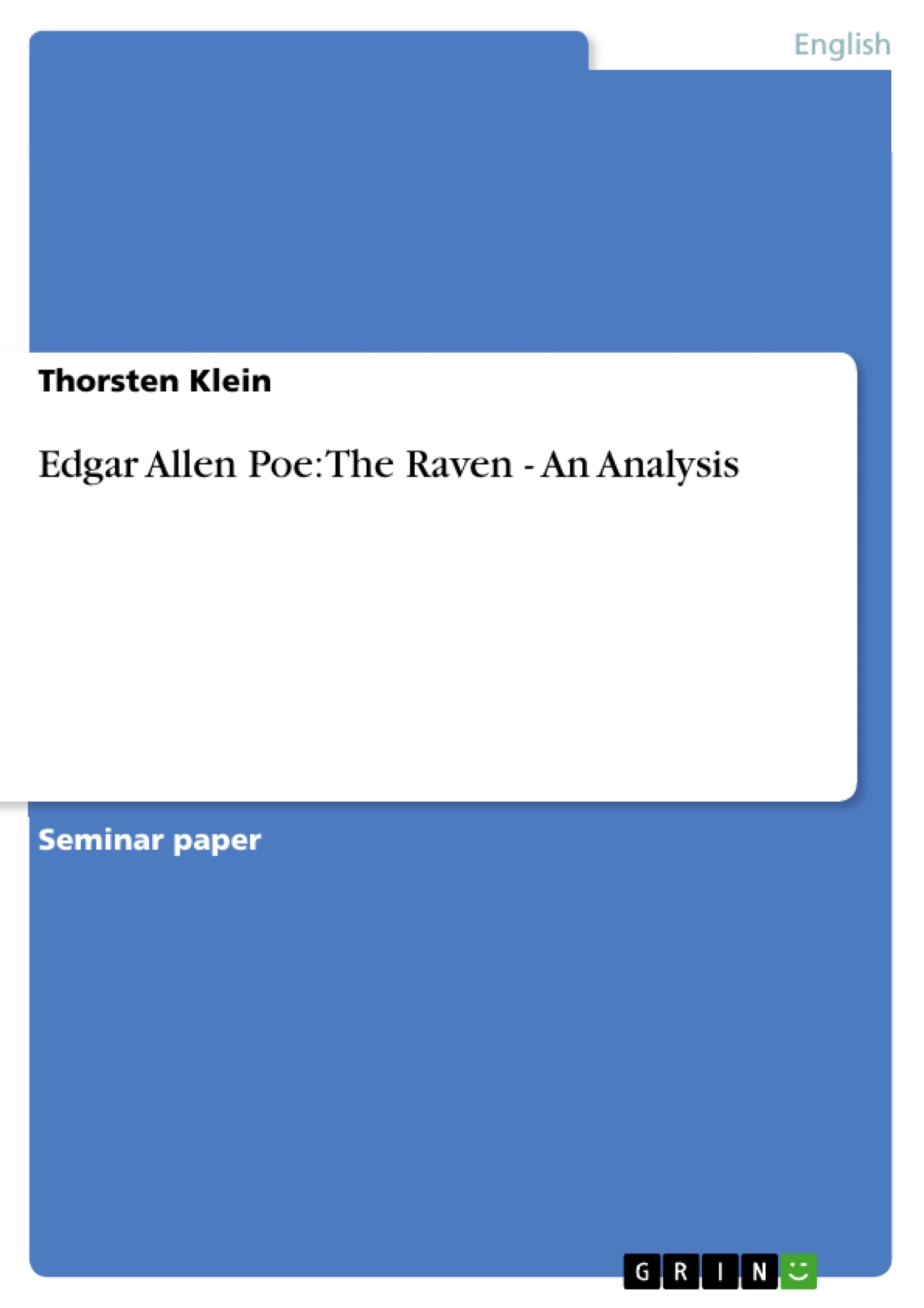The Ravenby Edgar Allen Poe is one of the most popular poems in literature. I chose this poem because of its tense, atmospheric and stylistic features. In this paper I will try to point out some of the most important features ofThe Raven.At first I will give some information about the life and work of the author Edgar Allan Poe and the plot ofThe Ravenwhich is said to be his best known piece of work. I will analyse the poem by looking at the arrangement of the poem and I will give some background information about the history of the text. In the Concluding remark I will summarize my results by trying to answer the questions if Poe’s life influenced the story that is told inThe Ravenand why the poem may be so famous.
Inhalt
1. Introduction
2. About the author
3. Analysis
4. Concluding remark
5. Bibliography
1. Introduction
The Raven by Edgar Allen Poe is one of the most popular poems in literature. I chose this poem because of its tense, atmospheric and stylistic features. In this paper I will try to point out some of the most important features of The Raven.
At first I will give some information about the life and work of the author Edgar Allan Poe and the plot of The Raven which is said to be his best known piece of work. I will analyse the poem by looking at the arrangement of the poem and I will give some background information about the history of the text. In the Concluding remark I will summarize my results by trying to answer the questions if Poe’s life influenced the story that is told in The Raven and why the poem may be so famous.
2. About the Author
Edgar Poe was born on January the nineteenth 1809 in Boston. His parents, David Poe jr. and Elizabeth Arnold Hopkins, were touring actors; both died before he was 3 years old, and he was taken into the home of John Allan, a prosperous merchant in Richmond, Virginia, where he was baptized Edgar Allan Poe. His childhood was uneventful, although he studied in England for five years (1815-20). In 1826 he entered the University of Virginia but stayed for only a year. He ran up large gambling debts that is stepfather refused to pay. Therefore he had to leave the college. He broke with Allan and went to Boston, where he published his first book of poems, Tamerlane and other Poems (1827). Because of not having any financial support and the book being unsuccessful, Poe enlisted in the army. In 1829 he left in order to accept an appointment at West Point, as an enlisted man. At this time he had already published Al Aaraaf, Tamerlane, and Minor Poems. After leaving West Point he asked his stepfather for financial assistance but Allan refused. He then moved to Baltimore in 1833 and lived in the home of his aunt Maria Glemm, where he fell in love with his cousin Virginia. His stepfather died one year later. Poe, his aunt, and Virginia moved to Richmond in 1835, and he became editor of the “Southern Literary Messenger” . In the same year he
married Virginia, who was only 14 years old at this time. Poe published fiction stories, among these was his most horrifying tale, Berenic e but most of his contributions were serious, analytical, and critical reviews that earned him respect as a critic. In January 1837 the issue of the “Messenger” announced Poe's withdrawal as editor but also included the first long prose tale, The Narrative of ArthurGordon Pym, five of his reviews, and two of his poems. Poe had success as a writer but he failed to satisfy his employer. In the following years he changed his jobs and places to live.
In 1845 Poe's poem, The Raven was published in The Raven and other Poems. Two years later, after his wife had died of tuberculosis, Poe turned more and more to drinking. Edgar Allan Poe died in October of delirium tremens in Baltimore.
3. Analysis
3.1. About the poem
A solitary figure sits alone in his chamber on a stormy night, tormented by the thoughts of his lost love, the beautiful Lenore. Suddenly, a menacing raven, a bird of ill-omen, flies through an open window and perches itself above the chamber door on the bust of Pallas. The protagonist asks himself aloud which could be the bird’s name and the bird replies with the famous phrase: “Nevermore!” Then the protagonist begins to ask the raven questions about his life and his lost love, which are all answered with the same word, the only word the raven is able to speak. The protagonist thinks of the raven as a prophet. Therefore the negative answers to all his questions destroy all hope for salvation.
[...]
- Citar trabajo
- Thorsten Klein (Autor), 2002, Edgar Allen Poe: The Raven - An Analysis, Múnich, GRIN Verlag, https://www.grin.com/document/62426




